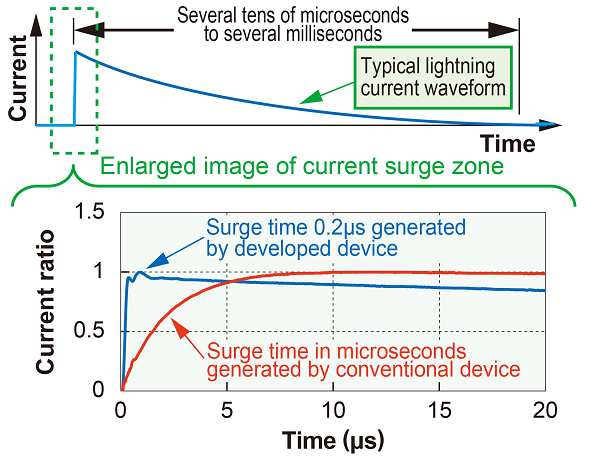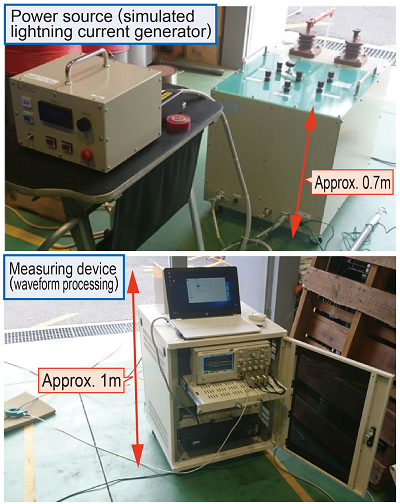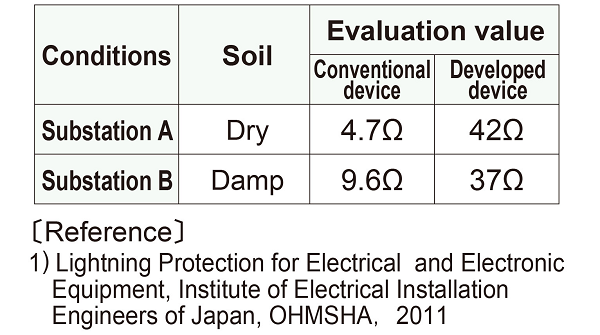2. Earthing system testing device for lightning protection in power supply installations
Lightning protection tests (high frequency) of earthing systems in fixed power supply installations cannot be carried out using ordinary earthing resistance tests (low frequency) because of the difference in frequency components of the testing currents. The current waveform of a lighting strike typically surges rapidly as shown in Fig. 1. Since lightning is a natural phenomenon, the surge time is random.
However conventional test results using simulated lightning currents surging in few microseconds were insufficient for the protection of ICT control equipment in fixed power supply installations, because ICT equipment is more vulnerable to lighting strikes than earlier relay-based control equipment.
Consequently, a new portable testing device for earthing system inspection was developed as shown in Fig. 2.
A new developed power source circuit optimized for earthing system testing was installed into the device.
Compared to the conventional equipment the circuit can generate a simulated lightning current with a faster surge in about 0.2 s (blue curve in Fig. 1). The new testing device can be used to evaluated lighting protection covering the 95th percentile of lightning strikes, according to reported statistics 1).
Furthermore, an automatic data processing function including an algorithm to calculate the evaluation value (earthing impedance) was developed and installed into the new testing device.
The function allows operators, such as railway maintenance workers, to carry out tests without the need for special skills.
Table 1 shows the test results from two substation earthing systems on a railway line in operation.
According to the results, compared to conventional devices, the developed device can evaluate conditions that are 3 to 10 times more critical.
The developed device can therefore be used for regular inspections, for detecting potential weaknesses in installations, and verifying the effect of earthing system designs in order to improve protection against lightning, etc.
Other Contents
- 1. Real-time hazard mapping system for localized heavy rainfall-induced disasters
- 2. Earthing system testing device for lightning protection in power supply installations
- 3. Vertical damper to suppress decrease in wheel load on container wagon bogies
- 4. Seismic reinforcement methods for improving anti-catastrophe performance of railway viaducts
- 5. Support System for verifying evacuation safety in case of station fire
- 6. Early railway line tsunami inundation forecasting method
- 7. System for determining the stability of slopes during snowmelt season
- 8. Measures for reducing damage to overhead contact line system due to bridge oscillations caused by passing trains
- 9. VR-based training to prevent man-vehicle collision accidents
- 10. Method for evaluating train running safety during earthquakes considering non-linear behaviour of structures
- 11. Critical wind speed of overturning based on actual measured lateral vibration acceleration
- 1. Real-time hazard mapping system for localized heavy rainfall-induced disasters
- 2. Earthing system testing device for lightning protection in power supply installations
- 3. Vertical damper to suppress decrease in wheel load on container wagon bogies
- 4. Seismic reinforcement methods for improving anti-catastrophe performance of railway viaducts
- 5. Support System for verifying evacuation safety in case of station fire
- 6. Early railway line tsunami inundation forecasting method
- 7. System for determining the stability of slopes during snowmelt season
- 8. Measures for reducing damage to overhead contact line system due to bridge oscillations caused by passing trains
- 9. VR-based training to prevent man-vehicle collision accidents
- 10. Method for evaluating train running safety during earthquakes considering non-linear behaviour of structures
- 11. Critical wind speed of overturning based on actual measured lateral vibration acceleration



